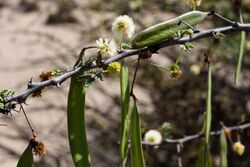Biology:Vachellia reficiens
| Vachellia reficiens | |
|---|---|

| |
| Scientific classification | |
| Kingdom: | Plantae |
| Clade: | Tracheophytes |
| Clade: | Angiosperms |
| Clade: | Eudicots |
| Clade: | Rosids |
| Order: | Fabales |
| Family: | Fabaceae |
| Subfamily: | Caesalpinioideae |
| Clade: | Mimosoid clade |
| Genus: | Vachellia |
| Species: | V. reficiens
|
| Binomial name | |
| Vachellia reficiens (Wawra) Kyal. & Boatwr.[2]
| |
| Subspecies | |
| |
| Synonyms | |
| |
Vachellia reficiens (Afrikaans: Rooihak, German: Rotrindenakazie), commonly known as red-bark acacia, red thorn,[3] false umbrella tree,[3] or false umbrella thorn,[4] is a deciduous tree or shrub of the pea family (Fabaceae) native to southern Africa, often growing in an upside-down cone shape and with a relatively flat crown.
Taxonomy
The Austrian naturalist Heinrich Wawra von Fernsee described Vachellia reficiens (as Acacia reficiens) in 1859. It forms a species complex with V. luederitzii, also from central and southern Africa.[5] Two subspecies exist: V. reficiens subspecies reficiens, which found in Angola and southwestern Africa,[5] and has affinities to V. luederitzii,[6] and V. reficiens subsp. misera which is found in eastern Africa, from Sudan and Somalia through Kenya and into Uganda,[5] and has affinities to V. etbaica.[6] With the re-typification of the genus Acacia[7] this species was placed in Vachellia.[8]
Description
Vachellia reficiens can grow up to 5 metres (16 ft) in height. Its bark is reddish-brown or greyish-black, and is quite rough and fissured. The younger growing branches can have a purple-red appearance, hence its common names. An interesting characteristic about this plant is that it has both, long, straight thorns and shorter curved/hook-like thorns, but generally not both in one pair. Leaves are bipinnately compound (as is common in most African acacia species) with 1 to 4 pinnae pairs, where each pinna again has 5 to 13 leaflet pairs. The flowers are white- to cream-coloured, and mostly seen during the summer months of December and January, but they can blossom almost all year round, depending on the geographical location. The fruit is a flat red-brown pod.
Distribution and habitat
Vachellia reficiens is found in the drier areas of Africa, in countries like Angola, South Africa, Eswatini and Namibia. This plant seems to prefer rocky soil-types and it does not grow in high-rainfall areas, but rather in semi-desert and arid shrubland.
It is an abundant dominant species of arid shrubland throughout Kenya,[9] and it forms up to 30% of total woody canopy in the South Turkana Ecosystem in the Turkana District.[10] In some savannas and woodlands Vachellia reficiens is a species of woody encroachment, crowding out herbaceous plants.
Ecology
This tree's leaves are browsed upon by game and small livestock like the Greater Kudu and goats.[10] In some areas of Namibia and Kenya, Vachellia reficiens subsp. reficiens is considered an invasive species as it can encroach on areas of farmland, especially on disturbed soil.[4] It is very opportunistic and hardy and can subsequently take over large areas of native vegetation.
Uses
The nomadic Ngisonyoka people in the Turkana District of Kenya use Vachellia reficiens wood to build temporary houses.[10] In Namibia's Kaokoveld region, the branches of this tree are used for fencing and the bark is used to curdle milk, while the thorns can be used to pierce ears. The seeds can be baked in hot ash, crushed, ground and mixed with tobacco to use as snuff.[11] The Giriama people use the wood for firewood and charcoal, and straight stems for poles.[12]
References
- ↑ Botanic Gardens Conservation International (BGCI) & IUCN SSC Global Tree Specialist Group (2019). "Vachellia reficiens". IUCN Red List of Threatened Species 2019: e.T144274527A149056372. doi:10.2305/IUCN.UK.2019-2.RLTS.T144274527A149056372.en. https://www.iucnredlist.org/species/144274527/149056372. Retrieved 29 December 2023.
- ↑ "Phylogenetic position and revised classification of Acacia s.l. (Fabaceae: Mimosoideae) in Africa, including new combinations in Vachellia and Senegalia.". Bot J Linn Soc 172 (4): 500–523. 2013. doi:10.1111/boj.12047.
- ↑ 3.0 3.1 Wiegand, Kerstin; David Saltz; David Ward; Simon A. Levin (2008). "The role of size inequality in self-thinning: A pattern-oriented simulation model for arid savannas". Ecological Modelling 210 (4): 431–445. doi:10.1016/j.ecolmodel.2007.08.027.
- ↑ 4.0 4.1 Bester, F. V. (1999). "Major problem-bush species and densities in Namibia". Agricola 10: 1–3. http://www.nbri.org.na/sites/default/files/Agricola1998_99_No10_02_Bester.PDF.
- ↑ 5.0 5.1 5.2 Ross, J. H.; Brenan, J. P. M. (1967). "Notes on Mimosoïdeae: X". Kew Bulletin 21 (1): 67–73. doi:10.2307/4108432.
- ↑ 6.0 6.1 "Vachellia reficiens (as Acacia reficiens)". Zipcodezoo.com. http://zipcodezoo.com/Plants/A/Acacia_reficiens/.
- ↑ International Code of Botanical Nomenclature (Vienna Code). Regnum Vegetabile 146. A.R.G. Gantner Verlag KG
- ↑ Maslin, B.R. 2008. Generic and subgeneric names in Acacia following retypification of the genus. Muelleria 26: 7–9.
- ↑ Forest Resources Division (December 2001). "State of Forest Genetic Resources in Kenya". Working papers FGR/18E. Rome, Italy: FAO. http://www.fao.org/DOCREP/004/AB396E/ab396e03.htm.
- ↑ 10.0 10.1 10.2 Coughenour, Michael B.; Ellis, James E.; Pop, Robert G. (1990). "Morphometric Relationships and Developmental Patterns of Acacia tortilis and Acacia reficiens in Southern Turkana, Keny". Bulletin of the Torrey Botanical Club 117 (1): 8–17. doi:10.2307/2997124.
- ↑ Sjöskog, Maja (2012). "Plants Around Gobabeb". Gobabeb Training & Research Centre. p. 101. http://issuu.com/majasjoskog/docs/plants_around_gobabeb.
- ↑ Pakia, Mohamed. "Plant Ecology and Ethnobotany of Two Sacred Forests (Kayas) at the Kenya Coast". http://146.230.128.141/jspui/bitstream/10413/3829/2/Pakia_Mohamed_2000_Vol2.pdf.
External links
Wikidata ☰ Q9568508 entry
 |


